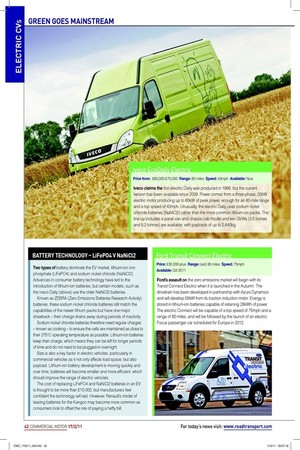BATTERY TECHNOLOGY – LiFePO4 V NaNiCl2
Page 35

If you've noticed an error in this article please click here to report it so we can fix it.
Two types of battery dominate the EV market, lithium-ion iron phosphate (LiFePO4) and sodium nickel chloride (NaNiCl2). Advances in consumer battery technology have led to the introduction of lithium-ion batteries, but certain models, such as the Iveco Daily (above) use the older NaNiCl2 batteries.
Known as ZEBRA (Zero Emissions Batteries Research Activity) batteries, these sodium nickel chloride batteries still match the capabilities of the newer lithium packs but have one major drawback – their charge drains away during periods of inactivity.
Sodium nickel chloride batteries therefore need regular charges – known as cooking – to ensure the cells are maintained as close to their 275oC operating temperature as possible. Lithium-ion batteries keep their charge, which means they can be left for longer periods of time and do not need to be plugged-in overnight.
Size is also a key factor in electric vehicles, particularly in commercial vehicles as it not only affects load space, but also payload. Lithium-ion battery development is moving quickly and over time, batteries will become smaller and more efficient, which should improve the range of electric vehicles.
The cost of replacing LiFePO4 and NaNiCl2 batteries in an EV is thought to be more than £10,000, but manufacturers feel confident the technology will last. However, Renault’s model of leasing batteries for the Kangoo may become more common as consumers look to offset the risk of paying a hefty bill.












































